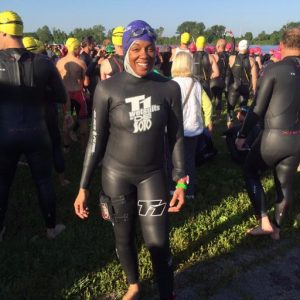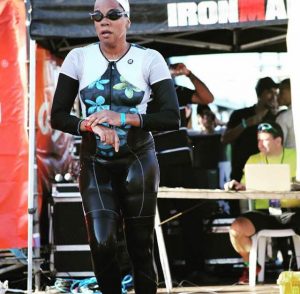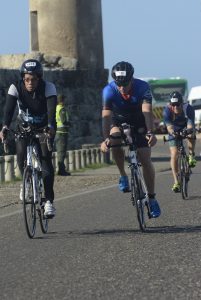Jeri Villareal is a modest and committed triathlete from St. Louis, Missouri. Working in the Information Technology Service Lead, this incredible 41 year-old mother is also an urban farmer. Her races usually include three continuous and sequential endurance disciplines which are swimming, cycling and running or better known as triathlon.
Nashata team regularly received Jeri’s pictures on Instagram account, @nashatadotcom wearing Hooda Sports Hijab while competing in her triathlon events. After following her account @modestlytri.ing for some time we knew that she is one of the amazing sportswomen that could inspire people to live with passion. Let’s follow our interview to learn more about Jeri’s incredible journey.
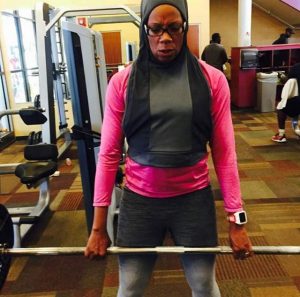
N: Nashata
J: Jeri
“I hadn’t ridden a bike in over 20 years.”
N: Do you remember your first triathlon? Tell us how you became a triathlete.
J: My very first triathlon was a small local race. It consisted of a 300 yard pool swim, 20 mile bike and 4 mile run. My swim was somewhat slow but steady but I got on my bike and was able to pass a couple of people. Unfortunately, I missed the turn off and ended riding an additional 4 miles. I was so upset but ended up continuing on to the run and finish last. I learned to always review the course before the race. There is nothing worse than getting lost during a competition.
N: What inspires you to become a triathlete?
J: I first started running. Running was something that I never thought I would be any good at. However, I used it as a way to ward off depression that developed for me in the short days of the winter months. Running outside made me happy and in the cool months, my hijab was comfortable. It was a great fit. I found that the more I ran, the better I became and I progressed from running in my neighbourhood, to running a 5K then 10K and half marathons. One day a friend of my family asked me if I had ever considered triathlon. I told her I hadn’t ridden a bike in over 20 years. However she told me that if she could compete at age 60, surely I could compete. I took up the challenge and learned to ride a bike and worked on my swim stroke. 7 months later, I competed in my first triathlon.
N: Where do you usually train?
J: I train at my local gym and also I created a workout room in my basement so there is no excuse for missing my training. I have a treadmill, a bike trainer, rowing machine, resistance bands and weights.
N: Did you have a coach when you first participate in your first triathlon event?
J: At the time of my first event. I did not have a coach. However, I did get a coach soon afterwards.
N: How different is it to train by yourself and with a coach for the event?
J: It is so helpful to train with a coach because they can see the small things that you do that could cause injury or they can make changes to your form so that you are more effective. Also they can give you specific exercises or workout to help improve your particular limitation to help your reach your personal goals quickly.
N: Which is the hardest part of triathlon?
J: For me, it’s open water swim. Especially in a lake. It make me a bit anxious when all I see is darkness in the water. I learned to overcome that fear by swimming in the pool with my eyes closed and only open my eyes when taking a breath. That exercise helps me relax once I get into the murky waters of a lake.
N: How do you tackled getting out of a wetsuit quickly? Is it an issue for a hijabis triathlete?
J: While many triathlons have “wetsuit strippers”, kind volunteers that will assist you in getting out of your wetsuit quickly. I avoid their help with the wetsuit. Their good intentions could result in uncovering more than of your body than you would want. I use a two-piece wetsuit consisting of pants with bibs and then a wetsuit top that goes over that. When I was exiting the water, I can unzip and remove the top without concern of revealing anything and I take the bib straps off of my shoulders. By the time I get to transition, I just have to roll down the pants and slip them over my feet. To me, the two-piece wetsuit is not only easy to get in and out of, it also is less constricting over your chest which can be helpful for those that feel chest constriction with traditional wetsuits.
“The hijab that has truly given me so much freedom in my life.”
N: As a Muslim triathlete who wears a hijab, have you ever experienced bitter moments where people would be prejudice about your religion? Do share your story with us.
J: The triathlon community is a very kind one in general. However I think a very well-meaning woman made a comment that she has seen me at several triathlons and she always “felt sorry for me” because I seems so uncomfortable. I didn’t even know how to respond. The last thing I expected was anyone to pity me for the chose that I made as a Muslim woman to wear hijab. The hijab that has truly given me so much freedom in my life. The comment sat with me for a long time and it really did affect me. I feel sorry for her that she didn’t understand the beauty of hijab.
“A quick conversation upfront can keep you from having a frustrating conversation with race officials on race day.”
N: What is your advice to the other Muslim women who are participating in triathlon event?
J: Speak to the race director to ensure that they are aware that will be competing fully covered. There are sometimes rules about how much of your body you can cover. A quick conversation upfront can keep you from having a frustrating conversation with race officials on race day. You do not need to ask “permission” to practice your religion. This conversation is simply to educate those that may not understand why they can’t write your race number on your leg or your arm. Or why you must cover your legs and arms during the swim when wetsuits are not allowed.
N: When is your upcoming event?
A: I just finished Ironman Cartagena 70.3 on December 3rd. That was my last event of the year. In 2018, I look forward to the local St. Louis Triathlon Olympic distance occurring in May. Later in the summer there is Ironman Steelhead 70.3 and Ironman Brazil 70.3
N: How is your diet like today? Was it different with what you usually have before being a triathlete?
J: Today I follow a fairly paleo diet. I enjoy eating lots of vegetables, some low-sugar fruits, meats and healthy fats but only consume ancient and sprouted grains sparingly me. Sweets are my weakness and I avoid sugar while training for a race. I usually tighten my diet 8 weeks from race day. Before becoming a triathlete I ate so much sugar. It was in everything and I didn’t even realize it. I was always a lover of green leafy vegetables though.
N: Describe the training process for a triathlon. How did you prepare–both mentally and physically?
J: Training for a triathlon means training for 3 sports. Additionally, as an athlete over 40 years old, it is vital to incorporate recovery into my schedule. I have 2-3 weekly swim workouts, 2-3 run workouts and 2-3 bike workouts. One of the workout will be either a speed or strength building workout like hill training or interval speed work. Also one of the workout will be endurance-based like a long run (5+ miles), a long bike (20+ miles) or a straight swim (2,000+ yards). I also do yoga twice per week for recovery and weight training twice per week.
During a heavy training load, 10 hours or more a week, I tend to get deep tissue massages. I also have tried alternative recovery techniques to combat inflammation such as cryotherapy and relaxing in an infrared sauna.
“I wear my Nashata Hooda Sports hijab while biking and running. It is thin and lightweight while keeping me dry.”
N: What do you wear for your triathlon event? Do you prepare specific sports gear for each of the activities?
J: I wear what is called a triathlon kit, which is a one-piece outfit with short-sleeves and shorts. The bottom of this kit includes a thin, waterproof pad for additional comfort on the bike. Under the kit, I have leg coolers and Nashata arm coolers. Each piece is designed for air-flow and a cooling effect. These extra pieces also provide coverage for modesty as well. Outside of the water, I put on a skirt for additional modesty while biking and running.
In the water, I wear polarized, prescription goggles. My vision is poor and these goggles are a lifesaver. While they come in clear and smoke lenses, the smoke lenses are my choice because they keep the sun and glare out my eyes when swimming.
I have bike shoes that have cleats on the bottom to connect my feet to my special bicycle pedals. This allows me to apply for force at a faster rate without fear that my feet will fly off of the pedals. My bike helmet is an extremely lightweight, aerodynamic helmet which is designed for speed and performance.
I wear my Nashata Hooda Sports hijab while biking and running. It is thin and lightweight while keeping me dry. The airflow is perfect for me on the bike because I am usually still wet from the swim.
N: We’ve seen you wearing Hooda Sports Hijab in your Instagram posts. Tell us your favourite Nashata wear.
A: Just one? Honestly, I love all of the options that Nashata provides! However I think Hooda is my favorite because of its practicality. It is also lightweight, quick-drying and provides wonderful airflow. These are all things that are vital to making a triathlete comfortable.
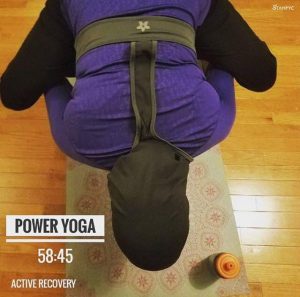
“In Arizona, Colorado, and North Carolina, you can practice bike skills such as climbing and descending on the bike.”
N: Where would you suggest new triathletes to go for a practice in The United States? Tell us the nicest spots you’ve ever been to.
A: There are so many options for practicing and building your skills in many areas of the United States. In Arizona, Colorado, and North Carolina, you can practice bike skills such as climbing and descending on the bike. This is usually a skill that is built with a lot of practice. The locations have long inclines for triathletes to build their climbing endurance. In Florida, there is an immersive swimming technique class for triathletes that can get them ready for open water swim by practicing certain techniques in the pool. Areas like southern Texas, Florida and California are great locations for triathletes in the rest of the country to practice in the very late or early season due to their mild winters. When it’s snowing in December in Missouri, I can swim outdoors in Orlando, Florida.
“I tried to leave every Colombian I met with a good impression of Muslims, Islam and Muslim women in sports.”
N: Have you ever participated a triathlon in a different country? What was it like?
A: December 3rd, I travelled to Cartagena, Colombia to compete in a Half Ironman. The experience was absolutely amazing. Arriving in the country I immediately noticed that people were very curious about me. They took photos of me and requested that I be in photos with them. The children that watched the race were very fascinated with me and called out to me specifically to cheer me on and told me that they loved me and referred to me as “Aunty”. As a Muslim woman competing in hijab in a foreign and predominantly Christian country, I know I am an ambassador for all Muslims whether I want to be or not. It is an honour that I take very seriously and I tried to leave every Colombian I met with a good impression of Muslims, Islam and Muslim women in sports.
N: What do you find to be the most rewarding thing about triathlon?
J: The challenge of triathlon is so great. I enjoy that fact that there are so many facets to the race. You can have an excellent swim and a difficult bike and turn everything around while running. There are people that are good at all three sports or some that find they excel in one particular sport over the other two. Regardless of your level of skill you will never participate in a triathlon and not hear a perfect stranger cheer for you and say encouraging words. When triathletes see someone struggling, that is they cheer for them the loudest. This sport is kind.
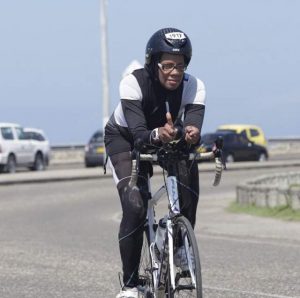
N: What is your advice to the new triathletes?
J: Remember that you don’t have to be better than anyone on the course, just be the best version of yourself. Be better than yesterday and keep moving forward.
N: What do you wish for in the future?
J: I would like to work on improving my swim and run times and work on my climbing skills. I believe I can be a better version of myself and look forward to seeing her very soon.
N: We wish you the best of luck in life! Thank you so much for agreeing to do the interview with us. We gained a lot of information from your wonderful experiences.
J: Thank you so much!
Sometimes we are too busy competing with other people that we overlook what’s truly important, to be the best version of ourselves. Be better than yesterday and keep moving forward. Thank you Jeri for the wonderful reminder!

